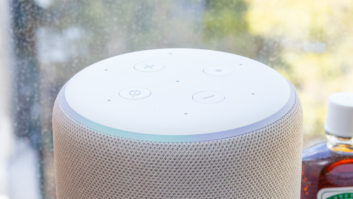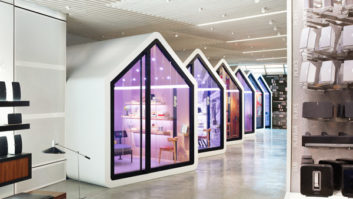
In mid-2004, Tom Cullen, then sales and marketing VP of a start-up company called Sonos, visited TWICE to extol the potential of the first-of-its-kind wireless multizone audio system.
The Sonos Digital Music System, which arrived the following year, was designed to broaden the customer base for distributed-audio systems by dramatically reducing the cost of entry compared to installed systems, Cullen told us. It was also targeted to consumers with substantial music collections on their PCs and to consumers who stream music over the Internet.
Ten years later, Sonos remains the biggest seller of such systems in the U.S., though multiple major brands have recently thrown their marketing weight behind the category.
To assess Sonos’s progress and its plans on the 10th anniversary of its product launch, TWICE spoke to Brad Duea, managing director for the Americas-Pacific region with responsibility for the United States, Canada, Latin America, Australia, New Zealand and Southeast Asia.
Duea discovered Sonos products in 2007 when he was president of Napster, an integrated music-service partner of Sonos.
Before joining Sonos, Duea was marketing senior VP for T-Mobile USA, responsible for all product management, including the sourcing, positioning and delivery of value-added services, devices and accessories. While at Napster, revenue increased from less than $12 million to more than $120 million, with international revenues increasing from zero to more than $20 million.
Here’s what Duea had to say:
TWICE: When Sonos launched its first products in early 2005, did it expect the wireless multizone-audio market to take off as much as it has in the U.S.?
Absolutely. The only difference is that we thought it would happen faster. We also thought music streaming adoption — a key component that fuels our growth — would be more robust than it was, but we are definitely on an accelerated growth curve now.
TWICE: What accounts for the popularity of wireless multizone audio?
The popularity comes from people loving music and them rediscovering the joys of listening to music out loud in any room or every room in the simplest way possible. Multiroom wireless/connected components is the only growth category in home audio, with some experts noting yearly growth rates right now of 88 percent in global unit sales year over year.
TWICE: How have your products, programs or distribution evolved since 2005 to meet evolving market needs?
We have constantly innovated, responded to customer demands and ideas and unceasingly improved the customer’s experience in the home. A good example of this is when we first launched, we had a dedicated controller that operated our system. Then the iPhone came out, and we saw the future of everyone having a controller in their pocket. We could’ve entrenched ourselves and kept the dedicated controller, but we knew that the ability to control Sonos from the phone (and whatever came after it) would be a better experience for our customers, so we developed the app and made it free.
TWICE: Has anything taken Sonos by surprise in its 10-year history?
Two things. First, music streaming has taken longer for consumers to adopt than we initially thought, but it is finally happening now — and rapidly. Second, the adoption of the smartphone has changed our product course a bit but has allowed us to deliver a better experience to our customers, allowing them to control Sonos from any phone or tablet.
TWICE: Many companies followed Sonos into the market. What has been the impact of the influx of competing brands on the market?
It is exciting to have more companies in the space. Competition pushes our innovation even higher, and it also helps to educate more music lovers on the joys of listening to music in the home. All of this means that our customers and potential customers will have the best music experience in the home possible.
TWICE: How has Sonos responded to the influx of new competitors? And how do you try to differentiate yourself?
We have not changed from focusing on the customer experience. It is what guides us in all of our decisions. Our focus on the customer and making their experience the absolute best we can has led us to make Sonos even more robust, easier to set up, and simpler to use. We’ve added more streaming music choices and introduced more speaker options to fill more rooms in the home. We will continue to do all these things until we fill every home with music.
TWICE: Has the market segmented into different niches based on price, features or demographics?
For audio in the home, there is little segmentation occurring. People are mostly looking to place their speaker of choice in any room they want and play their music in the simplest and most reliable way possible. They also want the best sound possible. All of these attributes are where Sonos is highly focused and where we excel.
There are many who may initially use a portable Bluetooth speaker to listen out loud both outside and in the home, particularly because of familiarity with Bluetooth. However, many people then discover Sonos and the superior experience, and they graduate to Sonos. Few people have successfully hosted a house party with a Bluetooth speaker.
TWICE: Sales of high-resolution music files are growing. What interest do you have in supporting playback of high-res music files from computers without reducing the resolution?
We support CD-quality lossless files when it comes to playback. A lot of people forget the quality of CD audio because as soon as it was hitting its stride, MP3s started becoming more prevalent. At the same time, people started erroneously attributing CD sound to that of MP3s. It is definitely not the case. CD-quality music is excellent. Let’s first get people back to CD quality before we start confusing the music lover with the subjective notion of the “superiority” of high-res 24/192 files.
TWICE: You’ve added Tidal’s CD-quality streaming service to your products. The music industry expects high-resolution streaming services to go online this year. How interested are you in streaming future high-res services?
For now we are interested in bringing as much of the playback on Sonos to the CD-quality level as possible. We’ll stay close to the consumer and what they desire from an experience standpoint.
TWICE: Any updates on how soon the Apple Music streaming service will come to Sonos?
We are excited to have Apple Music come into the music scene and have them highlight the joy of being able to stream all the music on the earth. We’ve long believed in the power of streaming, and having Apple share this vision is fantastic. We are working with them now and we’ll have Apple Music on Sonos by the end of the year.
TWICE: Would you be interested in adding Bluetooth support to your speakers, and possibly letting the speakers retransmit the Bluetooth stream to other speakers over Wi-Fi?
No. Bluetooth is a fantastic technology for certain situations. For example, having your device easily connect in a car is great. But for transmitting music into multiple rooms at a high sound quality level and in a way that is not marred by an incoming phone call or text message, Wi-Fi is the best solution.
With Sonos, the music is not dependent on the phone when you stream your favorite music from the Internet. With Bluetooth, if the phone moves more than 30 feet from the speaker the music stops. Not what you want during a dinner party.
TWICE: What challenges does the wireless multiroom audio market face?
Overcoming the apathy of OK sound quality is a challenge for us and our competitors.
Getting people to understand the joys of listening to music reproduced at a high sound quality and out loud. For too long, earbuds, laptop speakers and docks have been “good enough.” We are confident that as more music lovers experience the power of great sounding multiroom audio, this challenge will dissipate.
TWICE: Describe the wireless multiroom-audio market 10 years from now.
The market 10 years from now will be huge with high penetration into homes around the globe. It will have more music services and fantastic new ways for you to rediscover the music you love and discover the new music you will forever love. Ten years from now, the music that plays in a room will adapt even more to the room, who is in the room, what time of day it is, and even what type of day they’ve had.










